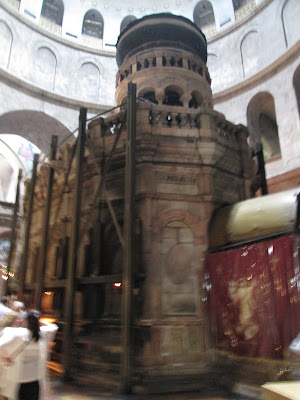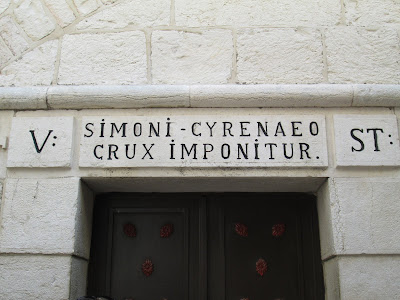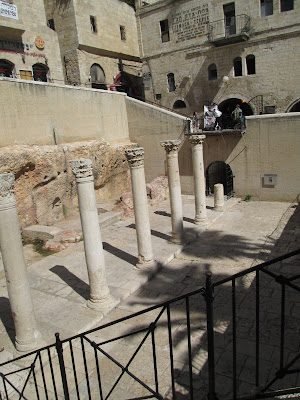Let me preface today's post......I thought my previous tour hit a few emotional points, but today definitely takes the cake (thus far). It was a very intense and emotionally draining day due to some of the places that were visited.
The morning started off heading to the city walls of Old Jerusalem; entering through the Zion gate. As we were about to enter our guide stopped for a moment and asked us to look closely at the wall, and to tell her what we saw. Many people said it looked like little holes like someone had been drilling, or just pitting in the bricks. Our guide told us what we were seeing were actually bullet holes. She said all around the walls of Old Jerusalem you will find the outside marred due to numerous wars that have happened throughout history; with the areas around the gates being the most prevalent because it was where people were at most often.
 |
| Zion Gate |
 |
| Outside walls riddled with bullet holes |
Upon entering the city we found ourselves in the Armenian Quarter. (Remember there are four quarters to Old Jerusalem: Jewish, Christian, Armenian, and Islamic.) We didn't spend any real time in the Armenian Quarter, mostly due to time constraints. What I observed was that it appeared to be very basic, nothing that jumps out and catches your attention....kind of like a very quiet and unobtrusive neighborhood. Our guide did point out that back in 1915 there had been an Armenian Genocide/Holocaust....something I knew nothing about.
Apparently the Ottoman government embarked upon the systematic decimation of the civilian Armenian population--simply to put an end to their existence. The Armenians were subjected to deportation, abductions, torture, and starvation. The deportations were disguised as resettlement programs, and most people were made to walk to their destinations (death marches); and while in the desert many died of hunger and thirst, or became exhausted due to the scorching heat. Those that survived the marches were taken to camps, but the Ottoman government had made no provisions for feeding the deported population; so, they were continually denied both food and water in an effort to speed up their deaths. It is estimated that up to a million in a half Armenians died.
Gee, does any of this sound familiar? Sounds like the Jewish Holocaust, just on a slightly smaller scale?
After exiting the Armenian Quarter we made our way to the Islamic Quarter where we began walking the Via Dolorosa. For those of you who may not know what the Via Dolorosa is, let me explain. It is the road Jesus walked from the place of Pilate's sentencing, to his crucifixion at Golgotha, and to his burial.
As I walked, I mindlessly followed our guide (not really listening), but was instead wrapped up in my own thoughts. As you walk through the busy corridors, there were vendors every where vying for my attention. They called out to you, trying to sell you their items; or trying to lure you into their store/booth to see what other great things they have for sale (that you most definitely 'need'). I was struck by how similar this may have actually been as Jesus walked this path. The area would have been overly crowded with people, people yelling and screaming at Jesus, but also those carrying on with business as usual.
As we walked there are stations along the way marking specific events that happened. I thought I would share a few of those with you.
Station 5--This is where Simon of Cyrene was forced by Roman soldiers to help Jesus carry the cross.
 |
| This small cavity is said to be the imprint of Jesus' hand as he stumbled (while Simon took the cross) |
Station 6--According to tradition is the location where St. Veronica wiped Jesus' face with her handkerchief, leaving an image of his face imprinted on the cloth. (I didn't know this, but the relic is kept at St. Peter's Basilica in Rome; if I had known that I would have looked for it while I was in Rome at the basilica.)
Station 7--Jesus fell for a second time, and this is marked by a Franciscan chapel.
Station 10--It is located at the entrance of the Church of the Holy Sepulchre, and it was where Jesus was stripped of his clothing. This picture shows the front of the Church of the Holy Sepulchre, but the station is actually on the right side, with the stairs leading up to a small chapel.
Station 13--This is where Jesus was taken down from the cross, laid down, and prepped for burial. He was laid down on this stone. Many believe that this stone has anointing powers, if the visitor kneels, prays and kisses the stone; also anything that touches the stone is said to become holy.
Station 14--Jesus laid to rest, in a borrowed tomb. Our group did not have the time to stand in line and wait to enter, but there was a back area where you could kneel down and reach up inside and touch a piece of a stone slab (with a crack in it). This is said to be the place where Jesus rested his head.
 |
| Red curtained area is where I went |
As mentioned before, it is impossible to know if these locations are the "exact" spots where things happened, but more than anything it is a journey. A journey to understand where Jesus walked, and to retrace those steps of history. Definitely makes the Bible come to life even more.
For more information, and other pictures of each station (we didn't enter inside any of them) you can check out this link: Via Dolorosa (pictures and stations)
Also within the walls of Old Jerusalem we walked part of the Western Cardo.
 |
| A painted mural of what the Cordo probably would have looked like |
After a rather intense walk, our group stopped for a brief lunch before getting back on the bus to visit our final destination of the day--Yad Vashem (the Holocaust museum).
This museum is so much more than just a museum, it is a living memorial to those who both passed away and survived the holocaust. The Jewish holocaust has always been a part of history that I was fascinated with, and can't ever seem to learn enough about. No matter how many books you read, classes you take, and photos I look at, my mind is still in awe as to the atrocity that occurred.
Now, I'm sad to report that they do not allow you to take pictures while in the main museum. It is very unfortunate because there is so much in there that should be shared, but at the same time I understand because the whole thing was so horrific that what is inside needs to be processed. You were allowed to take pictures outside, so I do have a few to share.
 |
| Entrance to the museum |
 |
| Hero's Memorial |
Names of the Righteous.....There are trees planted everywhere, with name plates in from of them. Our guide explained that each one of these is part of the Names of the Righteous, where non-Jewish people are honored for anything they may have done to help the Jewish population during the holocaust. It could be giving them food, shelter, creating false documents, hiding them, helping them escape, taking in children, etc.--seriously, anything. The individuals risked their own lives, and the lives of their families to help because if they were caught it was a death sentence. This particular woman, Irena Sendler was an ordinary woman who was a social worker. Irena would enter the ghetto, under the pretense of helping evaluate the sanitary conditions. Once inside, she made contacts and helped smuggle children out (via ambulance), and then placed them with non-Jewish families of orphanages. It is believed that she helped smuggle out approximately 2500 children. While Sendler did not see herself as a hero, she truly was. She did what so many others were too afraid to do. It was very interesting learning about her, I suggest you learn more about her and what she did at the following link: Irena Sendler
I attempted to take some pictures of the children's memorial, but nothing can even begin to do justice to what I experienced.
 |
| Borrowed this picture from the internet--nice, but still not as good as seeing it in person. |
I will recommend checking out their website: Yad Veshem Museum
I would also suggest that you google images of Yad Vashem, and Yad Vashem Children's Memorial




















No comments:
Post a Comment